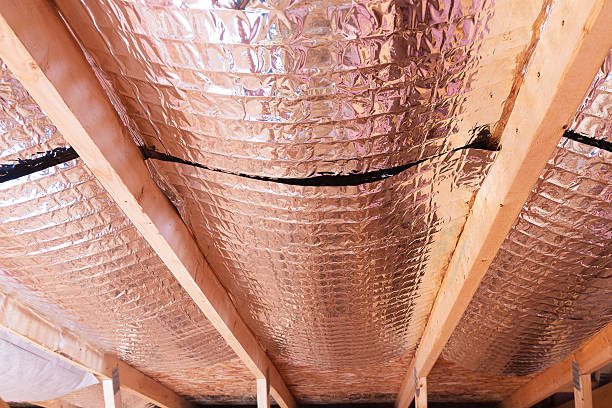Is a Radiant Barrier Worth It in Las Vegas?
June 11, 2024

When it comes to comfortable living, home insulation is a key tool—particularly in hot desert climates. Insulation keeps heat out of your home so cooling systems such as fans and air conditioning remain effective. In places like Las Vegas (which sees dozens of days over 100 degrees in a year), every degree makes a difference.
If you already have insulation, is a radiant barrier worth it? When used in concert with traditional insulation, radiant barriers keep a home even cooler by reflecting radiant heat away. This results in more effective cooling systems and more comfortable air, even on the hottest days of the year. When in doubt, call your local HVAC provider to ask questions and learn more.
What Is a Radiant Barrier?
Radiant barriers are just what the name suggests: they are barriers that prevent radiant heat from increasing the temperature in your home. They are made from highly reflective foil materials that reflect heat away. This way, the reflected heat does not enter your home air systems or travel to areas you especially want to keep cool, such as bedrooms.
Like insulation materials, radiant barriers are installed in attics and under-roof systems. However, traditional insulation materials (fiberglass, foam, cellulose, etc.) don’t reflect heat away like radiant barriers do. Insulation slows heat conduction by absorbing the heat.
These barriers are typically comprised of sheaths of reflective material installed in attic spaces with traditional insulation. This allows the two materials to work together to prevent overheating in a building. Both types of materials work to keep homes cooler, just in different ways.
How Effective Is Radiant Barrier Sheathing?
According to the U.S. Department of Energy, radiant barrier sheathing is very effective. It keeps so much heat out of homes that it can reduce cooling costs by up to 10%. The exact effectiveness of a radiant barrier depends on a variety of factors specific to the building it is installed in.
For instance, radiant barriers are particularly effective in reducing cooling costs when protecting attics that house air ducts. Air ducts are responsible for carrying cool air from HVAC systems throughout a home. If the ducts are protected from the heat with something like a radiant barrier, the system doesn’t have to work as hard to pump cool air throughout the house.
Other factors that may impact the effectiveness of radiant barriers include climate, other insulation measures, and the size of the attic space the barrier covers.
Can You Put a Radiant Barrier Under Shingles?
Radiant barriers rely on small amounts of empty air space to effectively block radiant heat. Radiant heat only travels across a void, so if there is no void, there is no radiant heat to block. The barrier will not do anything.
Because of this, radiant barriers are only effective when installed properly with air space between them and roofing materials. Only insulation materials that work against conductive heat can be installed “sandwiched” directly against other materials.
Radiant barriers cannot go directly under shingles or sandwiched next to felt underlayments. However, any roof type with air space between the roofing materials can benefit from radiant barriers.
Which Climates Benefit Most from Radiant Barriers?
Radiant barriers work the same way in any climate. However, certain climates have more radiant heat than other climates. The more heat that exists where you live, the more a radiant barrier will be worth it. You’ll recoup more savings against your investment and can put that money toward AC maintenance or emergency services.
Luckily for residents of hot deserts like Las Vegas, the year-round high heat of this climate makes it an ideal place for radiant barriers.
Those living in a colder or more moderate climate may find that the price of a radiant barrier is not worth it, as it will only protect against small or even negligible amounts of radiant heat.
Climates with cold, harsh winters will typically see little benefit from radiant barriers, as they will not significantly decrease cooling costs. A radiant barrier will not help indoor heating systems such as furnaces run more efficiently, so they are only helpful during warm seasons.
Does A Radiant Barrier Work Better in Older or Newer Homes?
Radiant barriers are typically easiest to install on new builds, as they can be placed at the same time as all other roofing materials. The contractor does not have to work inside a small, enclosed attic or schedule a special trip to perform the labor.
However, radiant barriers can be installed in both new and existing houses as long as certain conditions are met. Contractors need to be able to access the attic space to install the barrier, and roofing materials should be compatible with a barrier as well.
Radiant barriers work best when used with other insulation materials, so homes that already have (or will have) moderate amounts of insulation materials installed will benefit most from them. With no insulation, a home will not be protected enough with a radiant barrier alone as it will not absorb any conductive heat. If a home does not have enough insulation, insulation should be installed before a radiant barrier is added.
On the other hand, homes that already have significant amounts of insulation may not see large benefits from a radiant barrier. If no radiant heat makes it through the insulation, there is no need for an extra barrier and the cost of adding one may outweigh the benefits.
Whether your home is old or new, a qualified roofing contractor can evaluate your particular home to see if the structure will benefit from a radiant barrier.
Frequently Asked Questions
What is the downside of a radiant barrier?
Radiant barriers only protect against heat, so they aren’t very effective in cold or moderate climates. They also require air space between them and any other roofing or insulation materials in order to be effective, so they are only compatible with certain roofing structures and materials. In areas where they don’t produce significant savings on cooling costs, the installation price may not be cost-effective.
What is the purpose of a radiant barrier?
The purpose of a radiant barrier is to block radiant heat from entering a home. So how does a radiant barrier work? They are made from reflective material, which reflects heat away and allows cooling systems to work more effectively to keep a home comfortable—especially during hot weather.
What is the difference between radiant barrier and insulation?
While radiant barriers reflect radiant heat away from a structure, insulation absorbs heat, which slows heat conduction. Some homes only use insulation to keep heat away. However, when the two are used together, they are more effective at keeping homes cool.
Sealing and Insulation Professionals You Can Trust
Radiant barriers work to keep homes cooler and reduce cooling costs. They are especially effective in hot climates and in houses with insulated attic space. If you live in Las Vegas, Nevada, and want to save on cooling costs, your home is likely a good candidate for radiant barrier installation.
Call for a quote or schedule your radiant barrier installation today with YES!
Last Updated: June 11, 2024
